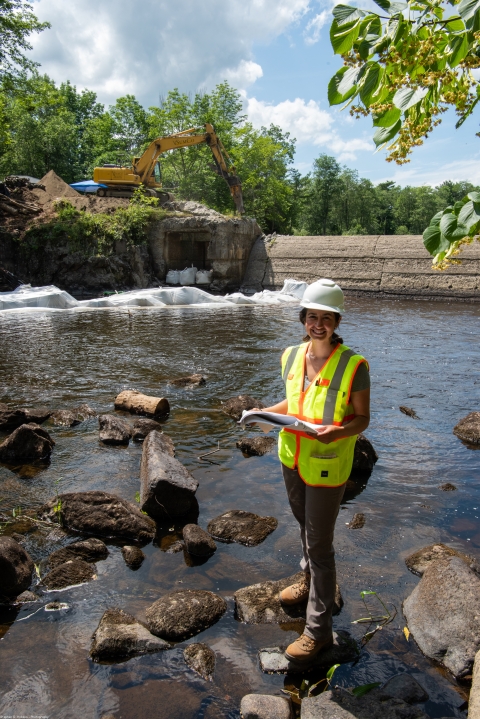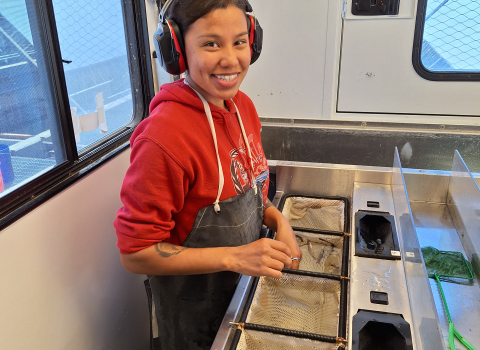While it’s been about 80 years since the last sawmill on Maine’s Sheepscot River closed, the dams that powered the iconic 66-mile river’s sawmills had remained intact — until recently.
In late 2019, with support from the U.S. Fish and Wildlife Service, NOAA’s Community-Based Restoration Program and others, the Atlantic Salmon Federation (ASF), Midcoast Conservancy, The Nature Conservancy and local partners took out a portion of Head Tide Dam in Alna, Maine, removing the first barrier migratory fish met when they headed up the Sheepscot from the Gulf of Maine in search of spawning habitat.
The project — which improved habitat for Atlantic salmon, shad, alewife and other sea-run fish — was one of 73 stream barriers removed in the North Atlantic-Appalachian Region in Fiscal Year 2020 with help from the Service.
Cumulatively, these projects opened migratory fish access to 596 upstream miles and 15,846 acres of freshwater habitat in 14 states — as far north as Maine and as far south as Virginia.
Importantly, many of these projects are also providing direct benefits for people. In recent years, intense storms have highlighted the risks to human safety and property posed by aging river infrastructure and failure of dams and outmoded culverts that cannot handle heavy floodwaters.
Removing or upgrading these structures can benefit public safety — and, in some cases, quality of life — through improved public amenities, and the Service is committed to continuing its river connectivity work in 2021 and beyond.
“We can restore these waters for the benefit of both fish and wildlife and the communities that live near rivers and streams,” said Cathy Bozek, fish passage fish passage
Fish passage is the ability of fish or other aquatic species to move freely throughout their life to find food, reproduce, and complete their natural migration cycles. Millions of barriers to fish passage across the country are fragmenting habitat and leading to species declines. The U.S. Fish and Wildlife Service's National Fish Passage Program is working to reconnect watersheds to benefit both wildlife and people.
Learn more about fish passage coordinator for the Service in the North Atlantic-Appalachian Region.
Restoring the Sheepscot: a fish — and people — tale
The Atlantic Salmon Federation-led effort along the Sheepscot River tackled a problem that was — quite literally — about 250 years old.
With the removal of the western portion of the Head Tide Dam, migratory fish that for decades had massed at the foot of the dam unable to swim upstream were able to do just that completely unencumbered.
“A dam has existed at the head of tide along the Sheepscot River since the 1760s, so modifying Head Tide Dam is an ecological milestone for the watershed,” said ASF Maine Headwaters project manager Maranda Nemeth.
But the project also reconnected the community to the river.
A portion of the dam’s spillway was left intact so that the town’s popular swimming hole would not be disturbed, while an accessible overlook compliant with the Americans with Disabilities Act was built at the dam opening to facilitate viewing of the river — and the fish runs. Parking was also improved to allow more people to enjoy the spot, and stairs were installed to facilitate safe access to the river’s edge.
“The Sheepscot River is famed for paddling, fishing, and birdwatching,” Nemeth said. “We worked closely with the immediate community to ensure the project achieved on-the-ground results that benefit people and will be an asset for decades to come.”
The project is part of a broader ASF-led Sheepscot River effort that also includes the full removal, in 2018, of Coopers Mills Dam in Whitefield and the establishment of a park at the site; new fishway construction in 2021 at Branch Pond Mill Dam; and additional fish passage projects.
Benefiting from lessons learned in Rhode Island
Sometimes, a river story is still mostly about the fish.
That is the case about 230 miles south of Alna, on the Annaquatucket River in North Kingstown, Rhode Island, where another key project was completed in FY20.
In the 1960s, the four dams along the Annaquatucket — historically the site of one of Rhode Island’s top river herring runs — were outfitted with fishways to allow fish upstream. Unfortunately, over time, changes in the streambed below two of the sites so negatively impacted fish passage that the runs disappeared.
The fishway at Belleville Pond dam in North Kingstown was one of those two sites, and in the latter part of last decade, the Service’s Fish Passage Engineering Team, through a contract with The Nature Conservancy, developed engineering design plans to mitigate the issue.
In fall 2020, TNC and the Rhode Island Department of Environmental Management (DEM) executed the plans, in part by excavating a portion of the river bottom and installing two rock weirs downstream of the ladder to create fish-friendly resting pools with a minimum depth of three feet.
“In the late 60s and early 70s, there was a push to build fish ladders, but without the benefit of custom designs,” said John O’Brien, The Nature Conservancy in Rhode Island’s policy and partnership specialist. “Those limitations — compounded by naturally occurring changes in the streams over time — mean that many older fishways are underperforming or no longer passing fish.”
“With the Fish Passage Engineering Group and (Service fish passage engineer) Bryan Sojkowski, we not only have the tools but also an understanding of herring we couldn’t dream of 50 years ago,” O’Brien said.
The Belleville Pond project followed successful work by TNC and DEM in 2019 to remove another barrier downstream on the Annaquatucket.
Come spring 2021, migratory fish on the river will begin to see the additional benefits.
Building a new Whiteoak Canyon Bridge: a model for success
Further south, a project at the Whiteoak Canyon Trailhead in Shenandoah National Park in Virginia shines a spotlight on another way river connectivity projects can yield co-benefits for people and nature.
Whiteoak Canyon has long been one of the most popular access points for Shenandoah National Park. But for years, a low-water crossing with undersized culvert pipes on Cedar Run, a tributary of the Robinson River, had been subject to flooding that limited public access, while also acting as a partial barrier to fish seeking the additional cold-water habitat upstream.
Late in 2019, the Piedmont Environmental Council, Trout Unlimited, and other partners removed the old structure and replaced it with a 35-foot high-water bridge that now provides safe and reliable public and emergency vehicle access to trails, in addition to fish and eel access to 3.5 miles of pristine steam habitat.
The Service’s Virginia Fish and Wildlife Conservation Office provided technical assistance and funding through the National Fish Passage Program for the project. The project is one of several — including another culvert replacement on the Robinson River — completed to improve aquatic connectivity and water quality in headwater streams bordering Shenandoah National Park.
It’s also an example of the type of project the Service is anxious to support throughout the North Atlantic-Appalachian Region — as the cumulative tally of 757 river barriers removed since 2009 with the Service’s help continues to grow.
“Depending on their locations, structures similar to Whiteoak Canyon low-water bridge can constitute public-safety risks in addition to being ecologically detrimental,” Service regional fish passage coordinator Bozek said.
“Removing dams and upgrading road-stream crossings can provide significant benefits for nature and people,” she added. “And that’s a long-term return on investment that’s worthy of precious public resources.”




